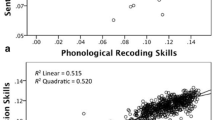Abstract
Reading and written spelling skills for words and non-words of varying length and orthographic complexity were investigated in normal Italian first and second graders. The regularity and transparency of the mapping between letters and phonemes make Italian orthography an unlikely candidate for discrepancies between reading and spelling to emerge. This notwithstanding, the results showed that reading accuracy is significantly better than spelling. The difference is particularly striking in first graders, but it is still evident in 2nd graders, though most strongly on non-words. The data show that reading and written spelling are non parallel processes and that the developmental asynchrony reflects a partial structural independence of the two systems.
Similar content being viewed by others
References
Agard, F. B. & Di Pietro, R. J. (1965).The sounds of English and Italian. Chicago: The University of Chicago Press.
Bradley, L. (1985). Dissociation of reading and spelling behaviour. In: D. D. Duane & C. K. Leong (eds.),Understanding learning disabilities (pp. 65–85). New York: Plenum Press.
Bradley, L. & Bryant, P. E. (1979). The independence of reading and spelling in backward and normal readers,Developmental Medicine and Child Neurology 21: 504–514.
Bryant, P. E. & Bradley, L. (1980). Why children sometimes write words which they do not read. In: U. Frith (ed.),Cognitive processes in spelling (pp. 355–370). London: Academic Press.
Bryant, P. E. & Bradley, L. (1983). Auditory organization and backwardness in reading. In: M. Rutter (ed.),Developmental neuropsychiatry (pp. 489–497). New York: Guilford.
Caramazza, A. & Miceli, G. (1989). Orthographic structure, the graphemic buffer and the spelling process. In: C. von Euler, I. Lundberg & G. Lennerstrand (eds.),Brain and reading (pp. 257–268). London: The MacMillan Press.
Carbonell de Grompone, M. A. (1974). Children who spell better than they read,Academic Therapy 9: 281–286.
Carlson, F., Elenius, K., Granstrom, B. & Hunnicut, S. (1985). Phonetic and orthographic properties of the basic vocabulary of five European languages,KTH Speech Transmission Laboratory, Quarterly Report 1: 63–94.
Chomsky, C. (1971). Write first; read later,Childhood Education 47: 296–299.
Cossu, G. & Marshall, J. C. (1985). Dissociation between reading and written spelling in two Italian children: Dyslexia without dysgraphia?,Neuropsychologia 23: 697–700.
Dejerine, J. (1892). Contribution à l'étude anatomopathologique et clinique des différentes varietés de cécité verbale,Comptes Rendues de Séances de la Sociéte de Biologie 4: 61–90.
Ferrero, F. E., Magno-Caldognetto, E., Vagges, K. & Lavagnoli, C. (1978). Some acoustic characteristics of the Italian vowels,Journal of Italian Linguistics 3: 87–96.
Fowler, C., Liberman, I. Y. & Shankweiler, D. (1977). On interpreting the error pattern in beginning reading,Language and Speech 20: 162–173.
Frith, U. (1980). Unexpected spelling problems. In: U. Frith (ed.),Cognitive processes in spelling (pp. 495–515). London: Academic Press.
Frith, U. (1983). The similarities and differences between reading and spelling problems. In: M. Rutter (ed.),Developmental neuropsychiatry (pp. 453–472). New York: Guilford.
Frith, U. (1985). Beneath the surface of developmental dyslexia. In: K. E. Patterson, J. C. Marshall & M. Coltheart (eds.),Surface dyslexia (pp. 301–330). Hillsdale, NJ: Erlbaum.
Gordinier, H. C. (1903). Arguments in favour of the existence of a separate centre for writing,American Journal of Medical Science 126: 490–503.
Harshman, R. & Krashen, S. (1972). An ‘unbiased’ procedure for comparing degree of lateralization of dichotically presented stimuli,UCLA, Working Papers in Phonetics 23: 3–12.
Marsh, G., Friedman, M. P., Welch, V. & Desberg, P. A. (1980). Development of strategies in learning to spell. In: U. Frith (ed.),Cognitive processes in spelling (pp. 339–352). New York: Academic Press.
Marsh, G., Friedman, M. P., Welch, V. & Desberg, P. A. (1981). A cognitive developmental theory of reading acquisition. In: T. G. Waller & G. Mckinnon (eds.),Reading research: Advances in theory and practice, Vol. 3 (pp. 199–221). New York: Academic Press.
Marshall, J. C., Caplan, D. & Holmes, J. M. (1975). The measure of laterality,Neuropsychologia 13: 315–321.
Ognjenovic, V., Lukatela, G., Feldman, L. & Turvey, M. (1983). Misreadings by beginning readers of Serbo-Croatian,Quarterly Journal of Experimental Psychology 35: 581–615.
Read, C. (1971). Preschool children's knowledge of English phonology,Harvard Education Review 41: 1–34.
Read, C. (1986).Children's creative spelling. London: Routledge & Kegan Paul.
Shallice, T. (1988).From neuropsychology to mental structure. Cambridge: Cambridge University Press.
Valtin, R., Jung, U. O. H. & Scheerer-Neuman, G. (1981).Legasthenie in Wissenschaft und Unterricht. Darmstadt: Wissenschaftliche Buchgesellschaft.
Waters, G. S., Bruck, M. & Seidenberg, M. (1985). Do children use similar processes to read and spell words?,Journal of Experimental Child Psychology 39: 511–530.
Wimmer, H. & Hummer, P. (1990). How German-speaking first graders read and spell: Doubts on the importance of the logographic stage,Applied Psycholinguistics 11: 349–368.
Author information
Authors and Affiliations
Rights and permissions
About this article
Cite this article
Cossu, G., Gugliotta, M. & Marshall, J.C. Acquisition of reading and written spelling in a transparent orthography: Two non parallel processes?. Read Writ 7, 9–22 (1995). https://doi.org/10.1007/BF01026945
Issue Date:
DOI: https://doi.org/10.1007/BF01026945




